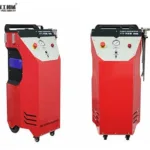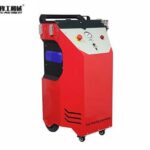Concrete floor bead blaster is a mechanical surface preparation machine that uses centrifugal force to propel small steel beads or shot material against a concrete surface. As the beads impact the surface, they remove dirt, coatings, and laitance while also texturing the concrete to improve coating adhesion. This process, often called shot blasting or bead blasting, is entirely dry and dust-free when paired with an integrated dust collection system. The bead blaster offers an eco-friendly and efficient solution with minimal cleanup time.
Features Defining the Modern Shot Blaster
Modern concrete floor bead blasters are engineered for precision and productivity, incorporating several defining features that set them apart as the preferred method for large-scale surface preparation.
- Captive Blast System. The most crucial feature is the enclosed system. The machine’s blast wheel propels the steel media onto the floor. Immediately following the impact, a powerful vacuum system sucks up the spent media, the pulverized contaminants, and the concrete dust. An air-wash separator then cleans the reusable steel shot, returning it to the hopper for recirculation, while depositing the fine debris into a connected dust collector. This closed loop minimizes waste and eliminates dust.
- Centrifugal Blast Wheel The heart of the machine is the blast wheel, which uses centrifugal force to hurl the abrasive media. It comprises vanes or blades that rotate at high speed. The size, speed, and design of this wheel determine the machine’s cleaning path and production rate.
- Adjustable Parameters: High-quality machines offer control over the desired surface profile. Operators can adjust the size and type of steel shot, the flow rate of the shot, and the travel speed of the machine.
- Mobility and Ergonomics: Larger industrial units are often self-propelled to ensure a consistent and even blasting pattern over vast areas, while smaller, walk-behind models offer superior maneuverability for tighter spaces and medium-sized projects.
Applications Where the Blaster Shines
The versatility of the concrete floor bead blaster makes it indispensable across numerous industries.
- Adhesive and Coating Removal: Efficiently stripping old, deteriorated coatings, paint, glue, mastic, and residual adhesives from floor surfaces.
- Contaminant Removal: Eliminating oil stains, grease, grime, and other embedded contaminants that would otherwise compromise the bond of a new coating.
- Non-Slip Profiling: Creating a coarse, slip-resistant texture on floors in wet environments, industrial kitchens, or loading docks for improved safety.
- Bridge and Road Deck Preparation is utilized extensively for large infrastructure projects to prepare concrete or steel bridge decks for overlays or protective treatments.
Advantages of Using a Concrete Floor Bead Blaster
- Superior Surface Quality
The blasting process creates an ideal surface profile for coatings to bond, improving durability and longevity. - Speed and Efficiency
Bead blaster can significantly reduce project time and labor costs. - Dust-Free and Clean
The integrated dust collector ensures minimal airborne dust, providing a safer and cleaner working environment. - Eco-Conscious Operation
With no need for water or chemicals, it reduces environmental pollution and conserves resources. - Cost-Effective Maintenance
The machine offers low operational costs over time due to reusable blasting media and low energy consumption. - Uniform Results
Provides consistent texture and cleanliness across the entire surface, ensuring professional-quality results.
Maintenance and Care
Proper maintenance ensures long-lasting performance and prevents costly repairs. Follow these maintenance guidelines for the concrete floor bead blaster:
- Inspect Blast Wheel Regularly: Replace worn blades and check for balance to maintain efficiency.
- Clean Dust Filters Frequently: Prevent clogging to ensure consistent suction performance.
- Check Media Quality: Remove broken or contaminated beads from the system.
- Lubricate Moving Parts: Maintain smooth operation and reduce friction wear.
- Monitor Electrical Components: Ensure wiring, switches, and connectors are secure and functioning properly.
- Store in a Dry Environment: Protect the machine from moisture and corrosion when not in use.



